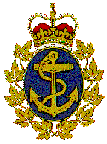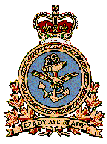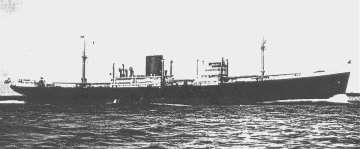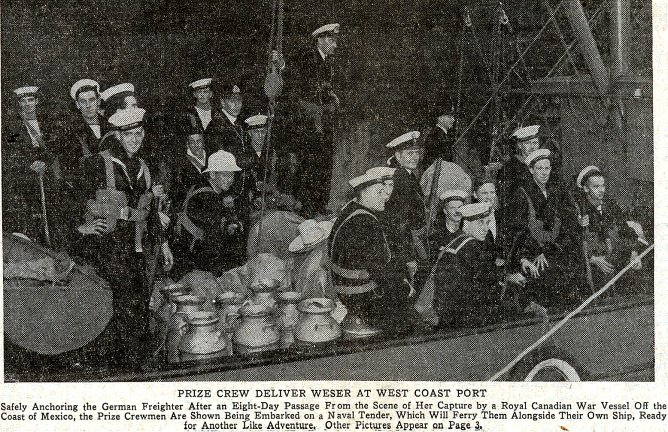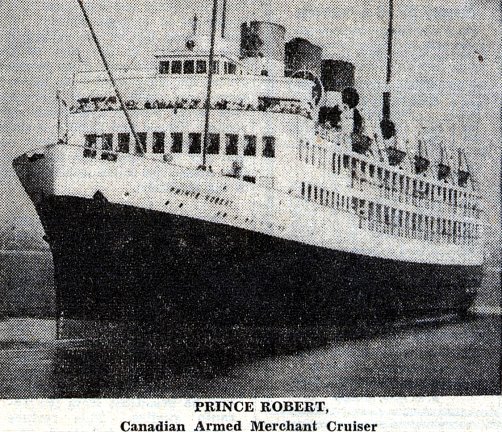Crew Had No Time to Sink Vessel
Officers and Men of Prince Robert Tell Dramatic Story of Seizing
Nazi Freighter
By Don Mason (Sun Ship Reporter)
"The Sunday Sun" (Vancouver Sun) ~ Saturday, October 5, 1940
One shell across her bows stopped and captured the Nazi cargo
liner Weser off Manzanilla (sic), Mexico a week ago–one star shell.
“It was almost too easy,” Commander Charles Taschereau Beard,
master of the armed merchant cruiser HMCS Prince Robert told me during
an interview in a West Canadian port, Friday.
The master of the German freighter thought he was being stopped
for routine examination by a Mexican gunboat. He had previously been informed
that no British naval vessels were in the vicinity.
HMCS Prince Robert–Port of Vancouver’s own fighting ship–was something
new to him.
“We had no trouble at all,” said Commander Beard.
He gave most of the credit for the capture to his second in command,
Lieut.-Commander G.B. Hope of Oak Bay, B.C.
He was the man who went aboard the Weser–the man who commanded
the prize crew that sailed her to Canada.
“I really mean it when I say that Lieut. Commander Hope deserves
a major share of the credit,” Commander Beard told me.
“He boarded that ship not knowing what would happen. He didn’t
know whether the Germans would blow off his head as he went over the side
or whether the ship had been mined.
“Fortunately we had two boatloads of men, about 20 in all, aboard
the Weser before they knew what was going on.”
The Weser, a ship well known in Port of Vancouver before war started–a
regular caller, in fact–was captured by the Prince Robert a week ago last
Wednesday.
She tried to sneak to sea out of Manzanillo, where she had skulked
for three months or longer. Lieut. Commander Hope told me his story:
“The Weser’s chief officer was standing at the top of
the companionway when I went aboard.
“He was a little stubborn, inclined to argue the matter with
me.
“I shouldered him aside. The sight of a Lewis machine gun took
the fight out of them–if there was any to be taken out.
“After that, it was plain sailing.”
The Weser was captured at 11:30 p.m., Sept 26.
“We had cruised up and down outside Manzanillo Harbor for a week.
“ Commander Beard told me.
“Yes, we wore a groove in the ocean,” said Able Seaman Charles
Anderson of Prince Rupert, a member of the “Robert’s crew.
SHIP KEPT HIDDEN
Commander Beard said:
“In daytime we cruised 30 to 40 miles off shore. At night
we came in closer–3 ½ to 4 miles out. I kept the Robert in the shadow
of a headland.
“We were hidden so that we could see the harbor mouth, but could
not be seen ourselves.
The Weser came out at 11:15 o’clock.
“Visibility was not good that night…a bit foggy it was,” said
Commander Beard.
“I moved in closer.”
Commander Beard was not sure, at first that his quarry was the Weser.
He’d been fooled before: An American freighter, built in Trieste,
Italy–not unlike the Weser–had passed by a day or two before. Commander
Beard ordered her to stop for examination. A British merchantman,
Port of Vancouver bound, was halted too.
It was an unfortunate stop for the Britisher. Her master thought
that the Prince Robert was a German raider. Immediately, as ordered by
the Admiralty, he threw all his records overboard.
“He was a very peeved captain when he found out who we were,”
said Commander Beard.
“Well, we got in close behind the Weser, to prevent her running
back into port,” the commander told me.
“We had to be careful about that three-mile limit, tool
ACTION STATIONS
“Every man aboard was at his action station. Everything was ready.
“I hailed the German commander from by bridge–by megaphone.
“That’ll tell you how close we were before he found out we were
in the Pacific,” the commander said.
The German freighter was ready for the Nazis’ favorite stunt–destruction
rather than capture.
But the Prince Robert gave her crew no chance.
“They had buckets of gasoline and diesel oil all ready.” Said
Lieut.-Commander Hope. “But we didn’t give them time to touch them off.
Commander Beard took up the story again: “The Weser’s commander–who
by the way, was Capt. H. Veit–her chief officer when she was last in Port
of Vancouver in peace-time–had no chance to get way from me,” he said.
“We were too close. I had the searchlight on my guns. He knew what he was
up against. He didn’t try anything."
CHANGED CAPTAINS
Commander Beard, whose guest, Captain Veit was during an eight
day voyage to Canada, told me that Capt. F. Voight, commander of the Weser
when last here, was relieved of his command three weeks ago.
The chief engineer of the Weser, and some of his men were just
lifting glasses of liquor to their lips to drink to a safe voyage and a
get-away when the Prince Robert’s searchlight came through his port.
“We got them just when they thought they were safe,” Commander
Beard said.
There was quite a sea running at the time, the commander declared.
He had intended to pull alongside the Weser, but had to send two boarding
parties instead…Lieut.-Commander Hope in chard.
The latter brought the Weser home to Canada with a prize crew
and some of the German engineers–who worked because they could do nothing
else.
There were 58 officers and men aboard the Weser.
“And they were a ‘cocky’ crew,” I was told.
When they came ashore for internment in Canada, some of them said:
“We’ll get the Weser back in a few weeks, as soon as we win the war.”
What a hope they have, according to crewmen of the HMCS
Prince Robert.
CATTLE ON BOARD
There were 15 head of cattle aboard the Weser and 15 hogs–for
food during the long trip back home.
Lieut-Commander Hope told me that the animals were slaughtered
and thrown overboard because they were diseased.
Four men of the Weser’s crew were taken to the Prince Robert’s
sick bay. All of them were scantily dressed–in clothing good for the tropics,
but not for wear in Canada.
The Prince Robert crew gave them what they could spare in the
way of trousers, jackets, sweaters, underwear. Several Robert seamen today
sport radios and other possessions they did not have before…because they
were good to the German prisoners.
Even Germans are not unappreciative when they are treated as human
beings.
Only men aboard the Weser wo were unappreciative were the officers.
Some of the crew weemed even glad to be captured.
Commnader Beard told me that 30 men from the Weser were taken
aboard the Prince Robert immediately.
“We gave them what clothing we could and fed them sandwiches and
hot coffee. They needed both badly,” he said.
The officers were taken to Commander Beard’s quarters.
EXPECTED EXECUTIONS
“They could not understand why they were not to be shot right
away,” said the commander.
They all did as they were told. They gave us no reason not to
trust them as people whose luck had run out….men who had loost a game.”
Commander Beard was careful to explain that the Weser’s crew had
no chance at all to fight–or even to destroy their ship: “We were
on top of them before they had a chance. When I hailed the German
commander, he answered in Mexican, believing my ship to be a Mexican gunboat.
He discovered his mistake too late, when were aboard him.”
Lieut. Commander Hope, who led the boarders on to the Weser, is
a well-known resident of Oak Bay. He joined the Royal Navy back in
1906, he told me Friday. The first warship he served aboard was the
battleship Vanguard–blown up during the First Great War. He has seen his
share of service, and more.
The Weser’s trip back to Canada from Mexico was slow because the
German freighter’s bottom is fouled with barnacles. She has not been drydocked
for overhaul for two years. Her loaded speed is 17 ½ knots,
and she can do about 20 knots when light.
FINE PRIZE
“She is a fine prize, and she can earn $500 a day for Canada
if she is put right to work after overhaul,” Commander Beard told me.
When the Weser was captured she had 300 tons of coke and several
hundred tons of peat moss aboard. Previously, cargo she had for Port of
Vancouver – whence she was headed when war started more than a year ago–was
unloaded at Punta Arenas, Costa Rica, and shipped overland to destination.
Commander Beard expressed the opinion that the Weser had intended
to attempt a return to Germany via Iceland and Norway. Both she and
the Prince Roberts were ‘blacked out’ when the speedy capture took place.
“There was no armament aboard the Weser other than a few revolvers
held by officers,” Commander Beard said.
The Canadian commander pays high tribute to his officers and men.
Especially does he give credit to Lieut.-Commander Hope and Warrant Engineer
Mathieson, who took charge of the Weser’s engine room.
“Most of my men were green when the Prince Robert sailed three
weeks ago,” he said. “They were from all over Canada. And they are real
seamen.”
I could tell by Commander Beard’s tone and facial expression that
he is more than proud of his men and his ship.
“For many of them, this was their first chance at action,” he
told me. “I am proud of the way in which they behaved.”
Commander Beard meant it – every word.
NAVY VETERAN
He is a real seaman, and a veteran in the Royal Candian Navy.
Commander Beard was the first cadet to enter the Royal Canadian
Naval Academy in 1908. He has been RCN ever since, except for two years
in retirement. This war he has been Commodore of Convoy on the Atlantic
and now commander of HMCS Prince Robert. Canada has reason to be
proud of him.
Extreme youth seemed to be the outstanding feature of the crew
of the Weser who came ashore for internment in Canada, Friday.
Commander Beard explained it. “The German merchant navy
expanded very fast before the war,” he said. “A good many extra apprentices
were taken on at small pay.”
The Canadian commander says that the Weser is worth about $1,500,000.
The Prince Robert’s crew members are glad to be home -- though
they have been at sea only three weeks. Capture of the Weser has
been “a lot of fun” to them.
